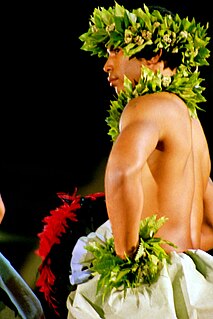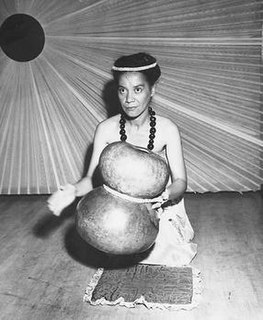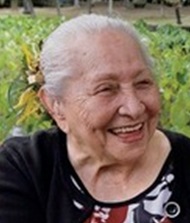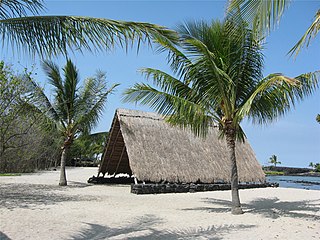
Hula is a Polynesian dance form accompanied by chant (oli) or song. It was developed in the Hawaiian Islands by the Polynesians who originally settled there. The hula dramatizes or portrays the words of the oli or mele in a visual dance form.

The Merrie Monarch Festival is a week-long cultural festival that takes place annually in Hilo, Hawaii during the week after Easter. It honors King David Kalākaua, who was called the "Merrie Monarch" for his patronage of the arts and is credited with restoring many Hawaiian cultural traditions during his reign, including the hula. Many hālau hula (schools), including some from the U.S. mainland and some international performers, attend the festival each year to participate in exhibitions and competitions. The festival has received worldwide attention and is considered the most prestigious of all hula contests.

Carleton Lewis Kealiʻinaniaimokuokalani Reichel popularly known as Kealiʻi Reichel, is a popular and bestselling singer, songwriter, choreographer, dancer, chanter, scholar, teacher, and personality from Hawaiʻi. He has spent his life educating the world about Hawaiian culture through music and dance.

President William McKinley High School, more commonly referred to as McKinley High School, is a comprehensive public high school in the Honolulu District of the Hawaii State Department of Education. It serves grades nine through twelve. McKinley is one of three schools in the Kaimuki-McKinley-Roosevelt Complex Area which includes Kaimuki High School and Roosevelt High School. It was founded as Fort Street English Day School in 1865. It was renamed in memorial to William McKinley, the twenty-fifth President of the United States, in 1907. President William McKinley High School is one of the oldest secondary schools in the state and several of its buildings have been listed on the National Register of Historic Places. The campus displays sculptures by Satoru Abe (1926–) and Bumpei Akaji (1921–2002). McKinley High School is accredited by the Western Association of Schools and Colleges through 2013.
A hālau hula is a school in which the ancient Hawaiian dance form called hula is taught. The term comes from hālau, a workshed, and hula, the traditional dance of the Hawaiian Islands.

Mary Abigail Kawenaʻulaokalaniahiʻiakaikapoliopelekawahineʻaihonuaināleilehuaapele Wiggin Pukui, known as Kawena, was a Hawaiian scholar, dancer, composer, and educator.

George Lanakilakekiahialiʻi Naʻope, born in Kalihi, Hawaiʻi and raised in Hilo, was a celebrated kumu hula, master Hawaiian chanter, and leading advocate and preservationist of native Hawaiian culture worldwide. He taught hula dancing for over sixty years in Hawaiʻi, Japan, Guam, Australia, Germany, England, North America, and South America.
Thelma H. Kalama, later known by her married name Thelma Aiu, was an American competition swimmer and Olympic champion. She competed at the 1948 Summer Olympics in London, where she won a gold medal in the women's 4×100-meter freestyle relay, together with her teammates Marie Corridon, Brenda Helser and Ann Curtis. The U.S. relay team set a new Olympic record of 4:29.2 in the event final.

ʻIolani Luahine, born Harriet Lanihau Makekau, was a native Hawaiian kumu hula, dancer, chanter and teacher, who was considered the high priestess of the ancient hula. The New York Times wrote that she was "regarded as Hawaii's last great exponent of the sacred hula ceremony," and the Honolulu Advertiser wrote: "In her ancient dances, she was the poet of the Hawaiian people." The ʻIolani Luahine Hula Festival was established in her memory, and awards a scholarship award each year to encourage a student to continue the study of hula.
Rae Fonseca was an American hula dancer and hula master. Fonseca established the Halau Hula O Kahikilaulani in 1980, a Hilo-based halau.
Nā Lei Hulu I Ka Wēkiu is a Hawaiian dance company or hālau hula led by kumu hula Patrick Makuakāne.
Fabianne Pomaialoha Wong Dalire, known professionally as Aloha Dalire, was an American Hawaiian kumu hula, or master hula teacher. She won the first Miss Aloha Hula as Aloha Wong, in 1971, the same year that the Merrie Monarch Festival was established. The Miss Aloha Hula title is hula's top solo wahine (women's) honor.
Isabella Haleʻala Kaʻili Desha was a highly regarded Hawaiian composer, musician and kumu hula during the Kingdom of Hawaii and throughout her life. She is descended from notable chiefly lines.
"Auntie" Alice Kuʻuleialohapoʻinaʻole Kanakaoluna Nāmakelua (1892-1987) was a Hawaiian composer and performer. Nāmakelua was also a kumu hula dancer and lei-maker. She was an expert performer of the slack-key guitar and a master of the Hawaiian language. Nāmakelua was a mentor of other musicians and wrote around 180 songs of her own. She was inducted into the Hawaiian Music Hall of Fame in 2011.
A Kumu Hula is a master teacher in the art of Hula. They usually run and participate in dance schools called Halau Hula.

Edith Kawelohea Kapule McKinzie was an American genealogist, educator, author, and an expert in hula and chant. She published two books on Hawaiian genealogy, was Director of the Hawaiian Language Newspaper Index Project, and taught traditional hula and chant across the United States. In 2004, she was named a Living Treasure of Hawaii for her contributions to Hawaiian culture and heritage.

Jaye Nāpua Nakasone is a Hawaiian musician, vocalist, songwriter, record producer, Kumu hula, and educator from Maui, Hawaii. Known primarily for her contributions as Kumu Hula of Hālau Nā Lei Kaumaka O Uka, Nāpua arranges traditional Hawaiian music as well, performing and recording with instruments such as ukulele, ipu, and other traditional Hawaiian hula implements. Nāpua has released four solo albums each earning a Nā Hōkū Hanohano Award.










